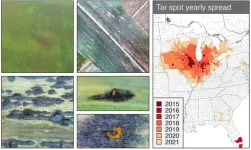(Press-News.org) First reported in 2015, tar spot is an emerging disease on corn that has rapidly spread across the United States and Canada, causing tremendous yield loss estimated at $1.2 billion in 2021 alone. Tar spot gets its name from its iconic symptoms that resemble the splatter of “tar” on corn leaves, but these spots are in fact brown lesions formed by the fungal pathogen Phyllachora maydis. This destructive pathogen is challenging to research because it cannot survive outside its plant host; therefore, little information is currently known about the mechanisms that contribute to its disease cycle including spore formation, reproduction, and plant infection.
Researchers have consequently come to rely on genome sequencing to identify what genes are present and predict what roles they play during disease development. However, the current draft genome is largely incomplete, and although genes are present in the fungus, they may not be expressed during infection. To address this, a recent study led by Joshua MacCready and Emily Roggenkamp from Martin I. Chilvers’s lab at Michigan State University generated a high-quality genome for P. maydis and provided the first global gene expression analysis of tar spot disease infection. The study, published in the journal Molecular Plant-Microbe Interactions, found that the fungus undergoes sexual reproduction early on in lesion formation, and this requires two individuals of different mating types.
This finding is significant because sexual reproduction allows the fungus more genetic flexibility to evolve, resulting in potentially more virulent or fungicide resistant isolates. Like many fungal pathogens, P. maydis relies on the secretion of proteins, called effectors, to manipulate and overcome plant immunity. This study identified over 100 effectors, many of which were found to be unique to this fungal pathogen and highly expressed during infection, suggesting that these proteins play a novel role during infection and warrant further investigation to determine their function.
The genome and gene expression analysis provides a valuable resource for other researchers studying tar spot on corn. Chilvers states, “This study lays the groundwork for future studies to examine effectors, pathogenesis, and the lifecycle of this pathogen.” Armed with an improved understanding about this fungus, these researchers aim to implement improved disease management tactics for this impactful pathogen.
For additional details, read Elucidating the Obligate Nature and Biology Capacity of an Invasive Fungal Corn Pathogen published in MPMI.
Follow the authors and institutes on X:
Martin I. Chilvers: @MartinChilvers1
Emily M. Roggenkamp: @EmRogge
Michigan State University Department of Plant, Soil and Microbial Sciences: @MSU_PSM
Michigan State University AgBioResearch: @MSUAgBio
Michigan State University College of Agriculture and Natural Resources: @CANRatMSU
Michigan State University Extension Field Crops: @MSUEFieldCrops
Crop Protection Network: @CropNetwork
About Molecular Plant-Microbe Interactions (MPMI)
Molecular Plant-Microbe Interactions® (MPMI) is a gold open access journal that publishes fundamental and advanced applied research on the genetics, genomics, molecular biology, biochemistry, and biophysics of pathological, symbiotic, and associative interactions of microbes, insects, nematodes, or parasitic plants with plants.
Follow us on X @MPMIjournal and visit https://apsjournals.apsnet.org/journal/mpmi to learn more.
END
It’s corn! It has the…spots? Researchers supply significant genomic insight into tar spot of corn
2023-11-06
ELSE PRESS RELEASES FROM THIS DATE:
Incheon National University scientists develop new hydrogels for wound management
2023-11-06
Open wounds, whether caused by accidents or from medical procedures like surgery, require proper management to speed up healing and prevent infections. While sutures and staples are common wound closure methods, they can cause secondary tissue injuries, potentially leaking fluids and gases and requiring anesthetics. Tissue adhesive glues are a more attractive alternative but often suffer from toxicity and weak adhesion.
Fortunately, tissue adhesive patches offer an innovative solution. They allow precise control of adhesion and mechanical properties through adjustable polymeric compositions. These patches can also deliver ...
Nasal microorganism to the rescue? Study confirms protective role of bacterium in chronic rhinosinusitis
2023-11-06
Like other countries in the world, Japan has witnessed a worrisome increase in the prevalence of chronic rhinosinusitis (CRS) over the last decade. An inflammatory disease that lasts at least 12 weeks, CRS can cause nasal congestion, nasal discharge, trouble breathing through the nose, facial pain, and even loss of sense of smell. Unfortunately, treating CRS is complex since the disease manifests in various forms. CRS can be categorized into eosinophilic (ECRS) or non-eosinophilic (non-ECRS) types. In ECRS, the nasal and sinus tissues exhibit an increased presence of eosinophils, a type of white blood cell that releases inflammatory ...
American Indian and Alaska Native adults had higher rate of premature heart attack deaths
2023-11-06
Research Highlights:
American Indian and Alaska Native adults had significantly higher death rates from premature heart attacks compared to white, Black and Asian/Pacific Islander adults in the U.S., according to an analysis of more than 370,000 heart attack deaths from 1999-2020.
In addition, despite an overall decrease in heart attack death rates among American Indian and Alaska Native adults during the last two decades, heart attack-related deaths in American Indian and Alaska Native adult men younger than 55 years old and women younger than 65 years old did not decrease.
Embargoed until 4 a.m. CT/5 a.m. ...
A child’s race, ethnicity and/or neighborhood may influence survival after cardiac arrest
2023-11-06
Research Highlights:
A child’s race, ethnicity and/or the neighborhood where they live may have an impact on their survival and recovery after a cardiac arrest.
Black children were more than four times more likely to experience a cardiac arrest compared to white or Hispanic children.
Children from neighborhoods with the highest socioeconomic status had the best odds of surviving and functioning well after a cardiac arrest.
Embargoed until 4 a.m. CT/5 a.m. ET, Monday, Nov. 6, 2023
DALLAS, Nov. 6, 2023 — Children’s ...
Marijuana use linked with increased risk of heart attack, heart failure
2023-11-06
Research Highlights:
As more people across the U.S. use marijuana for medical and recreational reasons, two new studies suggest its regular intake may damage heart and brain health.
In one study, daily use of marijuana raised the risk of developing heart failure by about one-third, even after considering other factors, compared to people who reported never using marijuana.
In a second study, older people with any combination of Type 2 diabetes, high blood pressure and high cholesterol who used marijuana, ...
Transgender adults in rural US had disproportionately higher cardiovascular disease risk
2023-11-06
Research Highlights:
In a small study of adults living in rural America, those who identified as transgender were more likely to have cardiovascular disease risk factors, including tobacco use, obesity, high blood pressure, Type 2 diabetes or insulin resistance, high cholesterol and/or alcohol use.
Study participants with the highest odds of having cardiovascular disease risk factors were transgender males.
The findings highlight the need for interventions focused on reducing health disparities among the transgender population, researchers said.
Embargoed until 4 a.m. CT/5 a.m. ET, Monday, Nov. 6, 2023
DALLAS, Nov. 6, 2023 — Transgender ...
Experimental pacemaker converts heartbeat energy to recharge battery
2023-11-06
Research Highlights:
An experimental, leadless pacemaker housing is able to partially recharge the device’s battery by generating electrical energy from heartbeats.
The device generated about 10% of the energy needed to stimulate another heartbeat.
The preliminary findings show that leadless pacemaker batteries may be recharged by converting the heart’s mechanical/pressure energy into electrical energy, however, more research is needed.
Embargoed until 4 a.m. CT/5 a.m. ET, Monday, Nov. 6, 2023
DALLAS, ...
Menstrual cycle disorders may be linked to increased cardiovascular disease risk in women
2023-11-06
Research Highlights:
High blood pressure risk was higher among adolescent girls with a condition associated with irregular menstrual periods called polycystic ovary syndrome, compared to teens without this condition, according to a study of girls between 13-17 years of age.
In a separate study of women younger than age 50, those with painful menstrual periods had a notably higher risk of heart disease compared with those women without the condition known as dysmenorrhea.
Researchers of both studies suggest future investigations focus on how these reproductive conditions may impact women’s long-term cardiovascular disease risk.
Embargoed until 4 a.m. CT/5 a.m. ET, Monday, Nov. ...
AI may accurately detect heart valve disease and predict cardiovascular risk
2023-11-06
Research Highlights:
Artificial intelligence (AI) and deep learning models may help to predict the risk of cardiovascular disease events and detect heart valvular disease, according to two preliminary research studies.
One study found that artificial intelligence analyzing sound data of the heart recorded from a digital stethoscope was able to more accurately detect heart valve disease than a health care professional who listened to the heart with a traditional stethoscope.
In a study evaluating data from the UK Biobank, an artificial intelligence/deep learning program effectively analyzed and sorted eye images ...
Depression, anxiety and stress linked to poor heart health in two new studies
2023-11-06
Research Highlights:
Depression and anxiety may accelerate the onset of risk factors for increased heart attack and stroke, according to a Boston-based study. People with a higher genetic sensitivity to stress developed a cardiovascular risk factor at a younger age, than people without the genetic marker.
A separate study based in Dallas found that cumulative stress contributed to health behaviors — such as smoking — that negatively affect cardiovascular health and potentially increasing plaque buildup in the arteries and other known cardiovascular disease risk factors.
Embargoed until 4 a.m. ...



